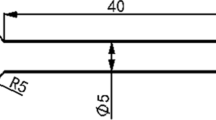Abstract
The aging hardening and evolution of precipitation phase of 7136 aluminum alloy during aging treatment were investigated. The research revealed that hardness of 7136 aluminum alloy firstly increases and then slightly decreases with increasing aging time, and reaches maximum values, which are about 198 HB when aging for 24 h. In addition, the dissolution peak of GP zones shifts towards high temperatures and coincides with that is characteristic of the dissolution peak of η' phase in the DSC curve; meanwhile, the dissolution peak area of η′ phase enlarges with increasing aging time. During aging progressing, the GP zones formed at first, then gradually dissolved, transformed into the η' phase, and eventually evolved into the η phase. Furthermore, the average size of the precipitated phase within the crystal increased from 3 to 5 nm, and the average size of grain boundary precipitation phase particles increases from 10 nm to about 20 nm with increasing aging time.





Similar content being viewed by others
REFERENCES
A. N. Petrova, I. G. Brodova, S. V. Razorenov, E. V. Shorokhov, and T. K. Akopyan, “Mechanical properties of the Al–Zn–Mg–Fe–Ni alloy of eutectic type at different strain rates,” Phys. Met. Metallogr. 120, 1221–1227 (2019).
P. K. Shurkin, N. A. Belov, A. F. Musin, and M. E. Samoshina, “Effect of calcium and silicon on the character of solidification and strengthening of the Al–8% Zn–3% Mg alloy,” Phys. Met. Metallogr. 121, 135–142 (2020).
I. G. Shirinkina and I. G. Brodova, “Annealing-induced structural–phase transformations in an Al–Zn–Mg–Fe–Ni alloy after high pressure torsion,” Phys. Met. Metallogr. 121, 344–351 (2020).
W. H. Sun, Y. A. Zhang, and X. W. Li, “Effect of solid solution treatment on microstructure and Properties of 7136 aluminum alloy,” J. Aeronaut. Mater. 34, 35–41 (2014).
H. Y. Li, L. jia, and J. N. Huang, “Precipitation behavior and properties of extruded 7136 aluminum alloy under different aging treatments,” Chin. J. Aeronaut. (2020) (in press).
I. Kalemba, C. Hamilton, and S. Dymek, “Natural aging in friction stir welded 7136-T76 aluminum alloy,” Mater. Des. 60, 295–301 (2014).
J. Z. Chen, L Zhen, S. J. Yang, and S. L. Dai, “Effects of precipitates on fatigue crack growth rate of AA7055 aluminum alloy,” Trans. Nonferrous Met. Soc. China 20, 2209−2214 (2010).
T. Wang, Z. M. Yin, K, Shen, J. Li, and J. W. Huang, “Single-aging characteristics of 7055 aluminum alloy,” Trans. Nonferrous Met. Soc. China 17, 548−552 (2007).
Y. Komura and K. Tokunaga, “Structural studies of stacking variants in Mg-base Friauf–Laves phases,” Acta Crystallogr., Sect. B: Struct. Crystallogr. Cryst. Chem. B 36, 1548−1554 (1980).
J. G. Tang, H. Chen, and X. M. Zhang, “Influence of quench-induced precipitation on aging behavior of Al–Zn–Mg–Cu alloy,” Trans. Nonferrous Met. Soc. China. 22, 1255–1263 (2012).
L. K. Berg, J. Gjonnes, V. Hansen, and X. Z. Li, “GP-zone in Al–Zn–Mg alloys and their role in artificial aging,” Acta Mater. 49, 3443–3451 (2001).
C. Garcia-Cordovilla and E. Louis, “A differential scanning calorimetry investigation of the effects of zinc and copper on solid state reactions in Al–Zn–Mg–Cu alloys,” Mater. Sci. Eng., A 132, 135–141 (1991).
X. Z. Li, V. Hansen, J. Gjonnes, “HREM study and structure modeling of the η′ phase, the hardening precipitates in commercial Al–Zn–Mg alloys,” Acta Mater. 47, 2651–2659 (1999).
X. M. Chen, R. G. Song, and H. X. Song, “Aging study of 7075 aluminum alloy with “twin peaks”,” Trans. Mater. Heat Treat. 31, 80–84 (2010).
M. H. Li, Y. Q. Yang, and Z. Q. Feng, “Precipitation sequence of η phase along low-angle grain boundaries in Al–Zn–Mg–Cu alloy during artificial aging,” Trans. Nonferrous Met. Soc. China 24, 2061–2066 (2014).
C. Y. Wan, J. X. Chen, and X. B. Yang, “7xxx series Al–Zn–Mg–Cu aluminum alloy early and middle aging study on enhanced precipitated phase,” J. Chin. Electron Microsc. Soc. 29, 455–460 (2010).
J. X. Zang, K. Zhang, and S. L. Dai, “Precipitation behavior and properties of a new high strength Al–Zn–Mg–Cu alloy,” Trans. Nonferrous Met. Soc. China 22, 2638−2644 (2012).
Y. Liu, Y. Huang, and Z. Xiao, “Effect of ultrasonic casting on microstructure and its genetic effects on corrosion performance of 7085 aluminum alloy,” Phys. Met. Metallogr. 118, 1105–1112 (2017).
I. G. Shirinkina and I. G. Brodova, “Annealing-Induced structural-phase transformations in an Al–Zn–Mg–Fe–Ni alloy after high pressure torsion,” Phys. Met. Metallogr. 121, 344–351 (2020).
Y. Q. Fan, K. Wen, and Z. H. Li, “Microstructure of as-extruded 7136 aluminum alloy and its evolution during solution treatment,” Rare Met. 36, 256–262 (2017).
Y. H. Zhao, X. Z. Liao, Z. Jin, R. Z. Valiev, and Y. T. Zhu, “Microstructures and mechanical properties of ultrafine grained 7075 Al alloy processed by ECAP and their evolutions during annealing,” Acta Mater. 52, 4589–4599 (2004).
X. G. Fan, D. M. Jiang, Q. C. Meng, and L. Zhong. “The microstructure evolution of an Al–Zn–Mg–Cu alloy during homogenization,” Mater. Lett. 60, 1475-1479 (2006).
Z. Guo and W. Sha, “Quantification of precipitation hardening and evolution of precipitates,” Mater. Trans. 43, 1273–1282 (2002).
Z. W. Du, Z. M. Sun, B. L. Shao, T. T. Zhou, and Q. Q. Chen, “Quantitative evaluation of precipitates in an Al–Zn–Mg–Cu alloy after isothermal aging,” Mater. Charact. 56, 121–128 (2006).
Funding
The financial support for this work is provided by the National Natural Science Foundation of China (no. 51871111), the Natural Science Foundation of Shandong Province (grant no. ZR2018LE001), the Science and Technology Program of University of Jinan (nos. XKY2036, XKY1713), the Key Research and Development Program of Shandong Province (Grant no. 2019GGX102008).
Author information
Authors and Affiliations
Corresponding author
Rights and permissions
About this article
Cite this article
Ran Wang, Ren, B., Dong, Y. et al. Microstructure Evolution Process of 7136 Aluminum Alloy during Aging Treatment. Phys. Metals Metallogr. 122, 383–388 (2021). https://doi.org/10.1134/S0031918X21040128
Received:
Revised:
Accepted:
Published:
Issue Date:
DOI: https://doi.org/10.1134/S0031918X21040128




